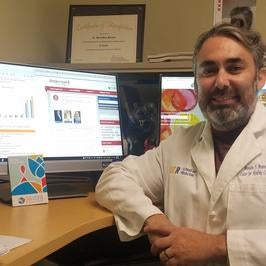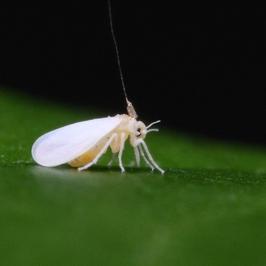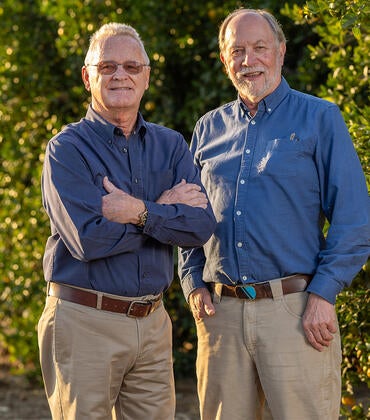
How does climate change affect California’s mountain lakes?
A team of researchers, including UCR’s James O. Sickman, a professor of hydrology, and Kevin Skeen, a research technician, has published a study in Limnology and Oceanography Letters showing that spring snowpack best predicts summer warming in small Sierra Nevada lakes.
Examining more than 30 years of climate and lake temperature data collected from Emerald Lake, Sequoia National Park, one of the more than 14,000 small lakes in the Sierra Nevada, the researchers found that summer temperatures in this lake are warming at an alarming rate: 1.5 degrees Fahrenheit per decade. The researchers conclude that climate change is impacting California’s mountain lakes, with the effects being somewhat buffered by snowpack.
The amount of snow, the researchers report, determines when the lake becomes ice-free, enabling a heating of the water due to more solar radiation absorption.
“Climate models are predicting that the Sierra Nevada’s snowpack will decline by 50 percent or more during the next 80 years,” Sickman said. “Since snowpack and snowmelt help keep summer lake temperatures at levels required for native fish, frogs, invertebrates and plankton, declining winter snowfall could have profound negative effect on lake biodiversity by the year 2100. Fortunately, our study shows that the highest elevation regions of the Sierra Nevada, located in Sequoia and Kings Canyon National Parks, will hang onto their snowpacks longer than in the northern Sierra, providing thermal refugia for cold-adapted species. Globally, identification of thermal refugia is important for a host of terrestrial and marine species including corals as global warming continues its relentless progress.”
The study was led by scientists at UC Davis, UC Riverside and UC Santa Barbara. More information here.
- Iqbal Pittalwala
Researchers determine topics weighing on Palm Springs HIV community
In a research paper published in the Journal of the Association of Nurses in AIDS Care, Brandon Brown, an associate professor of social medicine, population, and public health in the UCR School of Medicine’s Center for Healthy Communities, and colleagues explore the major health issues, resiliencies, and priority research topics related to HIV and aging among HIV patients, their caregivers, their providers, the community organizations that serve them, and researchers.
Brown and his coauthors focused their attention on Palm Springs, where prevalence of gay men living with HIV and older than 50 years is the highest in the country. More than 1 million people live with HIV in the United States, with as many as 25 percent likely unaware of their HIV status.
The researchers found five major themes reflected in the data they gathered: long-term side effects of medication, social determinants of health, mental health, resiliencies, and involving community in research.
“These themes are interesting because they not only reflect the community-driven topics where we should focus our research efforts, but also illustrate that community seeks more direct involvement in research, which can result in better and more sustainable outcomes,” Brown said. “The data we acquired could help us develop effective interventions, conduct useful and impactful research, and provide health care providers with the tools and knowledge to provide optimal care.
Brown was joined in the research by Logan Marg and Andrew Subica of UCR; researchers at UCLA; and community leaders in Palm Springs.
- Iqbal Pittalwala
Biologist proposes surface replicates
Every structure has a surface, and all animals, including humans, constantly interact with surfaces – ranging from insects walking on leaves to humans interacting with smartphones. Indeed, surfaces of animals and plants have inspired many biomimetic and industrial applications. Given the complexity of many natural surfaces, however, it is not always easy to use them in the lab. How then might they be replicated?
An international research team, including biologist Timothy Higham at UCR, established a two-step method, utilizing epoxy and then polydimethylsiloxane, or PDMS, for generating surface replicas, and then quantitatively assessed their quality.
“Surface replicates are ideal for exploring numerous questions related to ecology, evolution, and biomechanics,” said Higham, an associate professor of biology. “Using multiple forms of analyses, and multiple substances, we accurately replicated the leaves of several plant species, a rock surface, and a very young leaf. We expect this breakthrough will have far-reaching impacts on industry, basic science, and applied sciences.”
Higham explained that some surfaces are difficult to examine due to their relatively short lives, transparency, or unavailability due to their being a part of the fossil record.
“By replicating such surfaces, we can preserve their microstructure for long periods of time, and eliminate confounding factors such as chemistry, compliance, and curvature,” he said. “In some situations, such as the fossil record, replicates are our only option.”
The study, published in Philosophical Transactions of the Royal Society A, was led by researchers at the University of Freiburg, Germany, where Higham recently spent a year as an Alexander von Humboldt Fellow.
- Iqbal Pittalwala
Findings could help control crop pest
Can running an electrical current through whiteflies lead to better pest management? It can if the right material is used to do it, a pair of UCR entomologists posit.
Whiteflies are minute, plant sap-feeding insects that inflict major losses on agricultural crops such as tomatoes, eggplant, peppers, okra, and sweet potatoes. These insects produce a sticky substance known as honeydew, which can cause fungal diseases to form on leaves. To develop resistant cultivars and other whitefly control options, scientists need to know how whiteflies feed deep within the plant where their mouthparts cannot be seen. Kerry Mauck, an assistant professor of entomology, and her postdoctoral researcher, Quentin Chesnais, have come up with an insight into this using an instrument called an electrical penetration graph, or EPG.
“During EPG recordings, a whitefly is made part of an electrical circuit by attaching its body to a thin conductive wire,” said Mauck, who led the study. “When the insect inserts its mouthparts into the plant, the circuit is completed, and mouthpart activities inside plant tissues appear as visual signals that can be recorded and analyzed to identify resistant plant varieties and effective whitefly control treatments.”
In a paper published in the Journal of Insect Behavior, Mauck and Chesnais demonstrate that the thin conductive material most often used for whitefly EPG studies – 10-12 micron-thick gold wire – yields unreliable data because it inhibits normal whitefly movements. In contrast, whiteflies tethered with 2.5-micron platinum wire fed normally and responded predictably to resistant- and whitefly-susceptible host plants.
“Future EPG studies on whiteflies should use 2.5-micron platinum wire to ensure collection of accurate data on feeding behavior of these globally important agricultural pests,” Chesnais said.
The study was supported by UCR startup funds.
- Iqbal Pittalwala
Teachers’ differing levels of spatial skills may affect STEM learning
Spatial skills are critical for successful learning in science, technology, engineering, and mathematics, or STEM. Recent findings from a UC Riverside education professor suggest that many preschool and primary teachers lack strong spatial skills, the cognitive tools used to understand spatial relations between objects — both real and imagined —and to visualize and manipulate their positioning. These skills are used in learning math and science during childhood and adolescence, a time when teachers’ own abilities and attitudes play significant roles in shaping how their students learn.
Kinnari Atit, an assistant professor in UC Riverside’s Graduate School of Education, worked with three co-researchers to look closely at the spatial skills of high schoolers who later became precollege teachers. The team analyzed a nationally representative dataset to examine the skills of 4,428 educators divided into three categories: preschool and primary teachers, secondary STEM teachers, and secondary non-STEM teachers in subjects such as social studies and English. By comparing the future teachers’ results on series of standardized cognitive tests, the researchers found that secondary STEM teachers demonstrated exceedingly strong spatial skills — stronger, in fact, than those of the general population, college-graduate population, and all other teachers, with the gap between secondary STEM teachers and preschool and primary teachers appearing especially large.
According to Atit, the team’s findings highlight the need for additional research on how teachers’ spatial skills may ultimately affect students’ learning outcomes in STEM subjects, in particular. The full study, published in November by the American Psychological Association’s journal Archives of Scientific Psychology, can be viewed here. - Tess Eyrich
Conservative legislative group’s policy impact considered
According to new research from political scientist Loren Collingwood, a subset of well-funded, multi-issue political organizations may be discreetly shaping public policy across the country. In an article published in November in the Policy Studies Journal, Collingwood, an assistant professor of political science at the University of California, Riverside, examined the influence of a “legislative clearinghouse” called the American Legislative Exchange Council, or ALEC. On its website, ALEC bills itself as a “nonpartisan, voluntary membership organization of state legislators,” but as Collingwood noted, its primarily conservative membership also includes a variety of private entities and corporate sponsors.
“ALEC develops legislative proposals on myriad topics, which it promotes directly to its legislative members,” Collingwood said. By drafting “template legislation” that’s shared with members of the U.S. Congress, governors, and state legislators, among other elected officials and affiliates, organizations like ALEC become key players in a process called “policy diffusion.”
Collingwood and his co-researchers, UCR doctoral student Stephen Omar El-Khatib and San Diego State University’s Benjamin Gonzalez O’Brien, analyzed ALEC’s impact on the development of anti-sanctuary legislation between 2005 and 2017. The researchers compared the language found in 235 sanctuary-related bills produced during the 13-year time frame and that of a piece of “model” anti-sanctuary legislation promoted by ALEC to its members beginning in 2010-11. The researchers found ample text similarities between ALEC’s model legislation and anti-sanctuary bills subsequently produced around the country, with some of the bills even incorporating segments directly lifted from ALEC’s template.
“Our results indicate that ALEC is influential in the introduction of anti‐sanctuary legislation over the past seven years — specifically anti‐sanctuary city legislation in 2017,” the researchers wrote. Additionally, in a companion analysis, the researchers found that the more ALEC-affiliated legislators a state had, the more likely it was that the same state would debut anti-sanctuary legislation in 2017.
- Tess Eyrich





